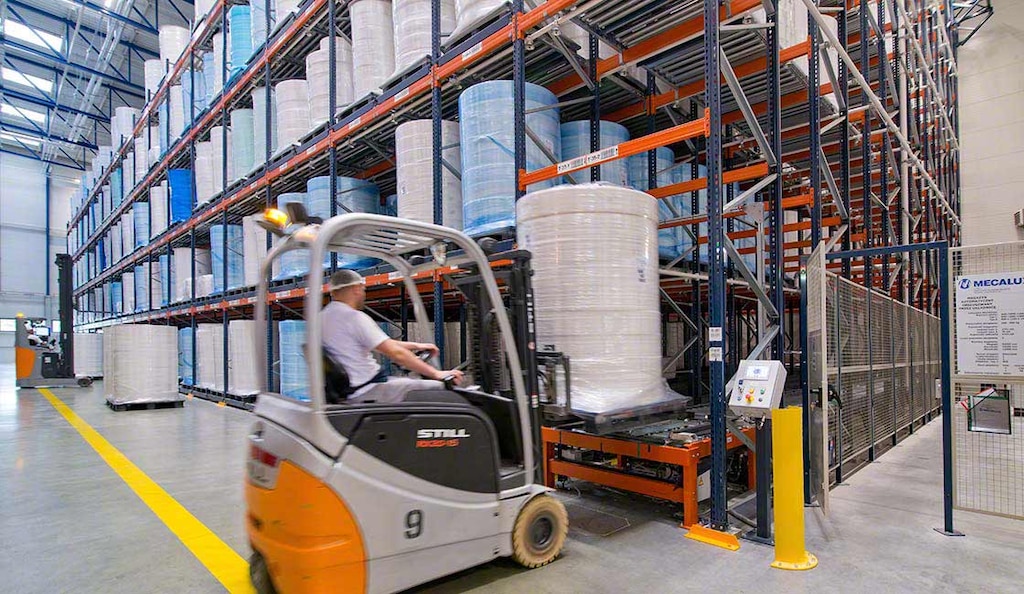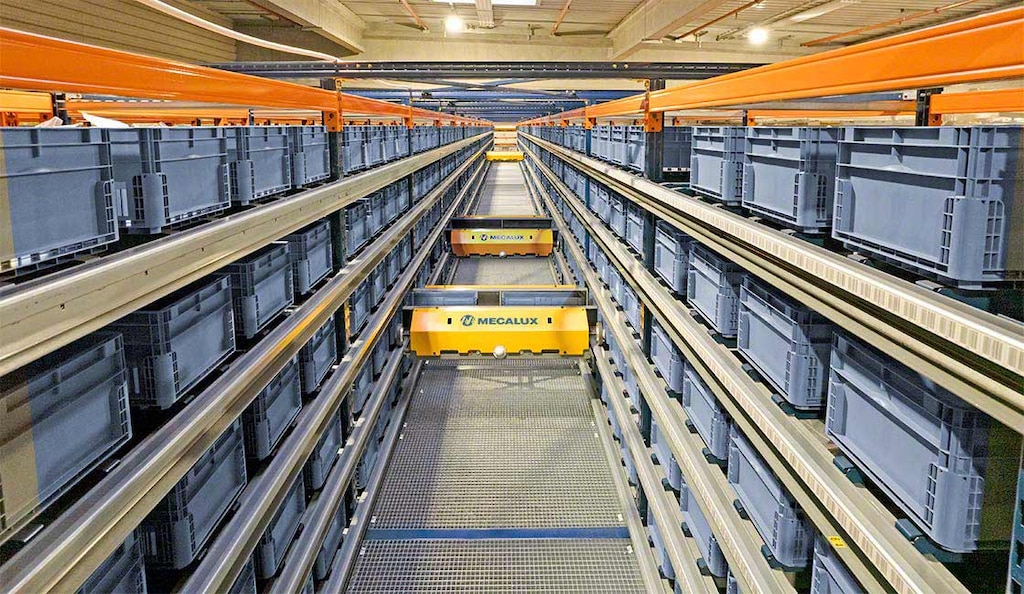
High-density storage system: Definition, examples, and benefits
High-density storage systems have become more essential than ever for maximizing space in logistics centers. With the growing demand for warehouse floor space, these compact structures condense the storage of goods and reduce the number of aisles required, making the most of every square inch.
Understanding the different types of high-density storage systems — along with their advantages and disadvantages — is crucial for choosing the solution that best fits each need.
What is a high-density storage system?
A high-density storage system optimizes space by limiting aisles for handling equipment and concentrating the storage locations of goods.
Unlike direct-access solutions, this system sacrifices individual access to all pallets within each storage channel to maximize space utilization.
Which racking systems are used for high-density storage?
Below is a comparison of the different manual and automated high-density storage systems available on the market.
Drive-in/drive-through pallet racking
Drive-in racks consist of a series of storage lanes that allow forklifts to enter the structure to load and unload pallets. This high-density racking is ideal for storing low-turnover products or large quantities of the same SKU.
Coca-Cola Refrescos Bandeirantes, for example, uses this system in its warehouse in Trindade (Brazil) to maximize storage capacity for bottled soft drinks from its production plant.

Push-back racking system
Push-back racks are an accumulative high-density storage system where loads are pushed along slightly inclined channels. Unlike drive-in racks, push-back racking doesn’t require forklifts to enter the structure.
In the US, the College of DuPage uses push-back racks in its Glen Ellyn (Illinois) warehouse to simplify pallet loading and unloading while enhancing operator safety.
Pallet flow racks
Pallet flow racks incorporate slightly sloped rollers that enable pallets to slide via gravity from the loading end of the channel to the opposite side. Pallet flow racking is perfect for implementing the FIFO method (first in, first out) and accommodating high-turnover goods.
Cosmetic and hygiene product manufacturer EcoWipes uses pallet flow racks with a stacker crane in its warehouse in Poland to streamline the storage of high-demand raw materials.

Mobile pallet racking (Movirack)
Mobile pallet racking is installed on mobile bases that move along rails embedded in the floor, allowing a single aisle to be opened when needed. Unlike other high-density systems, Movirack mobile racking offers direct access to all goods stored.
Giménez Ganga, a leading manufacturer of solar protection solutions, enclosures, and decorative blinds, leveraged Movirack mobile pallet racks to optimize space in its Sax (Spain) facility, increasing its storage capacity by 48%.
Semi-automated Pallet Shuttle
In the Pallet Shuttle system, a motorized shuttle loads and unloads pallets by running along rails within the storage channels. In the semi-automated version of this solution, a warehouse associate inserts the shuttle into the racking using a forklift. Another option is to manage it with automated guided vehicles (AGVs), as enabled by the WMS & Pallet Shuttle Integration module for Easy WMS, Interlake Mecalux’s warehouse management system.
Eridania, a major Italian distributor of sugar and sweeteners, implemented the Pallet Shuttle system to expand its capacity by 180% and to store and ship 1,750 pallets a day through automation.
3D Automated Pallet Shuttle
The most advanced version of this system is the 3D Automated Pallet Shuttle. It operates with a multidirectional electric shuttle that autonomously deposits and retrieves pallets from the racking, eliminating the need for additional handling equipment such as stacker cranes or transfer cars. A series of elevators transport the shuttle between levels, ensuring a smooth flow of goods and highly efficient storage.
In Tordesillas (Spain), food company Clavo Food Factory will boost its warehouse productivity with the 3D Automated Pallet Shuttle. This state-of-the-art automated storage and retrieval system (AS/RS) will enable the facility to handle an annual production of 15,400-plus tons of frozen and refrigerated products.
Shuttle System
The Shuttle System is an AS/RS for boxes designed to streamline order picking. It provides a continuous flow of products from storage locations to pick stations, optimizing the efficiency and speed of this logistics process.
Manitou Group, a company specializing in material handling, people-lifting, and earthmoving equipment, installed the Shuttle System in its facility in Ancenis (France). The numbers speak for themselves: 500 order lines filled per hour and storage of 20,000 totes in just 6,028 ft².

What are the benefits of a high-density storage system in a warehouse?
High-density racking offers several benefits in a warehouse. Its key advantages include:
- Maximum space utilization. By requiring fewer aisles, high-density pallet racking allows for greater product storage within the same area, increasing capacity without the need for physical expansion.
- Efficient inventory management. It supports batch storage or expiration-date-based organization, enabling FIFO or LIFO (last in, first out) control to improve inventory turnover.
- Lower operating costs. In cold-storage facilities, it minimizes the refrigerated area, reducing energy consumption.
High density, high performance
High-density storage systems are an effective solution for optimizing space usage and improving operational efficiency in warehouses. By increasing storage density and streamlining inventory management, these systems keep operating costs down while improving supply chain agility. If you’re looking to implement this type of logistics solution to stay competitive in an increasingly demanding environment, contact us. We’ll show you how you can maximize your performance in minimal space.
